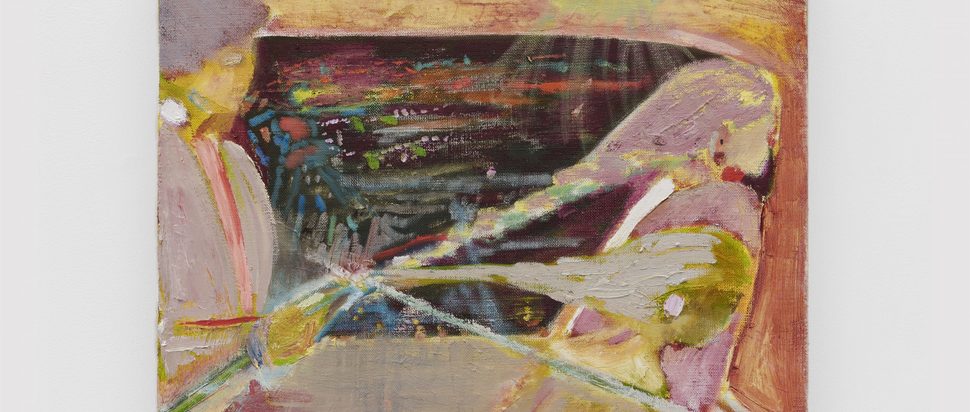Gabriella Boyd on new exhibition Presser
Gabriella Boyd's new exhibition at Cample Line encourages us to witness the beauty of ambiguities in communication and perception
On first look, most is uncertain. There are figures reaching out to one another. Strange objects appear, seemingly incongruous. Organs rest easy outwith a body. Corners become vantage points. Walls bend to the will of emotions unsaid. Muted colours pile atop one another while a sharp pink or alarmed orange refracts the scene. “I often work out what my paintings are doing after I’ve made them,” says Gabriella Boyd.
Presser, at Cample Line, is Boyd’s first solo exhibition in Scotland. Born in Glasgow, Boyd moved to London as a child, before returning to attend Glasgow School of Art. Although now based in London full-time, Scotland has always felt like home.
Presser includes both new work from the last year, as well as paintings from Boyd’s recent solo exhibitions. Although it’s the first time she’s done this, she found it “quite natural to re-introduce them.” Boyd’s body of work stretches into one, returning to similar themes and frequencies throughout. “I don’t really work in a project-based way,” she says.
In Boyd’s work, a tether – between people, places, principles – calls for our attention and calls us to attention, with a grace quite unspeakable. “I like trying to bear witness to the role connection plays in living and in our lives, and the ultimate clunkiness and impossibility of communicating that in a painting, or even in language,” says Boyd, over a grainy phone line. “It’s something that consumes us.”
Boyd’s practice is studio-based, most days. She notes that being an artist can be such a “soupy” existence. The studio provides a structure to that un-structure, a structure which can then be restructured from within. “Often when I get there, I’ll move my paintings around. I’m often working on multiple paintings at once – maybe ten to fifteen – so I’ll play with combinations and see what they do to each other.” Placement and replacement isn’t intended to form a collection – nor a polyptych of any sort. Rather, for Boyd, the process can allow each work to become more “itself” when placed in relation to another. “Sometimes, what a work needs is to be left alone.”
Early on, she’s working intuitively; as the project progresses, it becomes more particular, more solution-based, even. “There’ll often be an affection of the painting that’s stopping the rest of the work from working – and that’s what I’m drawn to. And then I’ll let the whole painting operate around that.”
A constant in her process, the show also includes pencil and watercolour on paper. “They’re not preliminary drawings – they’re alongside my practice, sometimes saying goodbye to potential versions of paintings or working out something quickly. Or it could be a texture on a piece of paper that I like and it’s on the wall for a year.”
Whether looking to a photograph, a painting, a song, or a text – Boyd allows her peripheries to fill up, before taking them to the studio and working with the overflow. Childhood cartoons, even, come out to play. “Even cartoons I watched growing up somehow resurface – Tom and Jerry or Ren and Stimpy with their organs on the outside of their bodies – every episode was based on some sort of power relation."
Such references – however pressing – are rarely all that evident on first meeting; rather, each painting tugs the knowing into the unknowing, and back again. Abstract and representational at once, her paintings and practice speak to an “oscillation between the two.”
“It’s like when you say a familiar word over and over again, it loses its sense of solidity and starts to disintegrate,” she continues. Boyd isn’t interested in replication – “worldbuilding” however, pulls her in. She considers her paintings as “psychological spaces”, allowing for the discrepancies between the experiences of our mental and physical states. As such, the spaces – whether a bus, a bedroom, a street – of her paintings are oftentimes stretched, spilling into and scratching upon each other. “I like the awkwardness of painting them, sometimes literally painting them on top of one another,” she says. “The room is just a vessel to catch that invisible but often palpable feeling."
Cample Line, located in rural southwest Scotland, seemingly gives itself to Presser as a fruitful companion. During the installation, there was much Boyd didn’t expect, such as, “The colours of the beam picking up certain things in paintings, and the concrete floor having a slightly different effect on the paintings and choosing which works to put there.” Outside, Cample Line will lend itself also – from the fresh cusp of spring to the mild and greening summer. Such shifts will spill in from the windows, almost at painting height, throughout the show. Boyd is excited about the spatial possibilities, passing light invited in with welcome and ease.
Gabriella Boyd, Presser, Cample Line until 2 Jun, for more detailed opening times visit campleline.org.uk/gabriella-boyd
